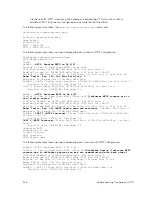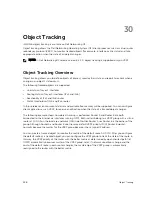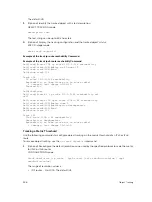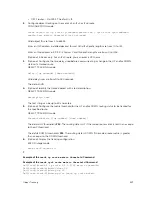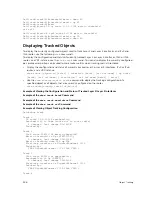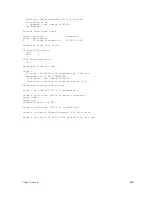
30
Object Tracking
IPv4/IPv6 object tracking is available on Dell Networking OS.
Object tracking allows the Dell Networking Operating System (OS) client processes, such as virtual router
redundancy protocol (VRRP), to monitor tracked objects (for example, interface or link status) and take
appropriate action when the state of an object changes.
NOTE: In Dell Networking OS release version 8.4.1.0, object tracking is supported only on VRRP.
Object Tracking Overview
Object tracking allows you to define objects of interest, monitor their state, and report to a client when a
change in an object’s state occurs.
The following tracked objects are supported:
• Link status of Layer 2 interfaces
• Routing status of Layer 3 interfaces (IPv4 and IPv6)
• Reachability of IPv4 and IPv6 routes
• Metric thresholds of IPv4 and IPv6 routes
In future releases, environmental alarms and available free memory will be supported. You can configure
client applications, such VRRP, to receive a notification when the state of a tracked object changes.
The following example shows how object tracking is performed. Router A and Router B are both
connected to the Internet via interfaces running OSPF. Both routers belong to a VRRP group with a virtual
router at 10.0.0.1 on the local area network (LAN) side. Neither Router A nor Router B is the owner of the
group. Although Router A and Router B use the same default VRRP priority (100), Router B would
normally become the master for the VRRP group because it has a higher IP address.
You can create a tracked object to monitor the metric of the default route 0.0.0.0/0. After you configure
the default route as a tracked object, you can configure the VRRP group to track the state of the route. In
this way, the VRRP priority of the router with the better metric as determined by open shortest path first
(OSPF) automatically becomes master of the VRRP group. Later, if network conditions change and the
cost of the default route in each router changes, the mastership of the VRRP group is automatically
reassigned to the router with the better metric.
538
Object Tracking
Summary of Contents for Z9000
Page 1: ...Dell Configuration Guide for the Z9000 System 9 7 0 0 ...
Page 80: ...grub reboot 80 Management ...
Page 128: ... 0 Te 1 1 Te 1 2 rx Flow N A N A 128 Access Control Lists ACLs ...
Page 491: ...Figure 70 Configuring OSPF and BGP for MSDP Multicast Source Discovery Protocol MSDP 491 ...
Page 496: ...Figure 73 MSDP Default Peer Scenario 1 496 Multicast Source Discovery Protocol MSDP ...
Page 497: ...Figure 74 MSDP Default Peer Scenario 2 Multicast Source Discovery Protocol MSDP 497 ...
Page 498: ...Figure 75 MSDP Default Peer Scenario 3 498 Multicast Source Discovery Protocol MSDP ...
Page 760: ...Figure 100 Single and Double Tag TPID Match 760 Service Provider Bridging ...
Page 761: ...Figure 101 Single and Double Tag First byte TPID Match Service Provider Bridging 761 ...



